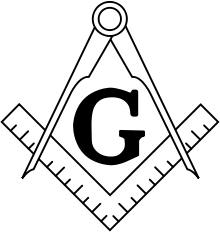Masonic Order of Liberia
The Masonic Order of Liberia is a fraternal organization based on the principles of Freemasonry. It tended to restrict its members to Americo-Liberians and was influential within the ruling True Whig party from its founding until the coup of Samuel Doe in 1980, when much of its senior leadership was killed. Though the Masonic Lodge remains a prominent, if unused, building in Monrovia, its members no longer wield the same political power.
Origins
The Masonic Order of Liberia was formed based on principles of Freemasonry, which had been gleaned by former slaves from their masters in the United States prior to their being "returned" to Africa under the auspices of the American Colonization Society. The Lodge was founded by Prince Hall Freemasons.[1]
Expansion and Political Dominance
The Grand Lodge of Liberia was founded in 1867.[2] By the 1970s there were 17 subordinate lodges and the majority of Liberia's high-ranking officials were Masons.[2] Matters of state were widely believed to have been decided from within the lodges.[2] Being a Mason was a veritable prerequisite for positions of political leadership in the True Whig Party.[2] Liberia's Masons were criticized for their influence as well as for the exclusion of indigenous Liberians from their ranks.[2]
Destruction and prohibition

After Master Sgt. Samuel Doe assumed leadership in a coup d'etat in 1980, Liberia's masons suffered the most savage attacks of any African affiliate. [3] The President of Liberia and the order's Grand Master, William R. Tolbert, Jr., was overthrown and killed in the coup.[4] Freemasonry was banned by Doe in 1980 and the political monopoly formerly held by the Americo-Liberians and the Masonic Order was destroyed and the Masonic Order's influence in Liberia greatly diminished. During the First Liberian Civil War, the lodge palace in Monrovia was the scene of many battles,[5] and its ruins became home to thousands of squatters.[6]
After the Civil War
In 1987 there was a special Prince Hall meeting held in New Orleans to elect a new Grand Master, and this was followed by a meeting in Monrovia in 1988.[7] On trial, President Charles Taylor made light of allowing his troops to post human heads and skulls of enemies at checkpoints, saying it was no worse than the display of skulls in “Western fraternal organizations.” [8]
The Masons evicted squatters from the Grand Lodge by 2005,[6] and plans to rebuild the Lodge have been reported. According to the Grand Lodge's 2015 reports, there are 19 Subordinate Lodges in Liberia with a total membership of 1,750. [9] Benoni Urey, a Freemason who is considered Liberia’s richest man and a possible candidate for the Liberian presidency, has said he wants to see the Masonic Order of Liberia return to prominence in Liberian politics. [10]
References
- ↑ The Tragic History of Freemasonry in Liberia, Chris Hodapp, Freemasonry for Dummies Blog
- 1 2 3 4 5 Monrovia - Masonic Grand Lodge
- ↑ Wauther, Claude (September 1997). "A strange inheritance". Monde Diplo. Retrieved 13 June 2015.
- ↑ The Tragic History of Freemasonry in Liberia, Chris Hodapp, Freemasonry for Dummies Blog
- ↑ Old Ruling Elite Making a Comeback in Liberia, Tim Sullivan, Associated Press, September 29, 2001.
- 1 2 Liberia- No More War, Jessie Deeter, Frontline (PBS), May 2005.
- ↑ The Tragic History of Freemasonry in Liberia, Chris Hodapp, Freemasonry for Dummies Blog
- ↑ Hodapp, Chris (29 June 2015). "The Tragic History of Freemasonry in Liberia". freemasonsfordummies.blogspot.com. Retrieved 13 October 2015.
- ↑ "Grand Lodge of Liberia A.F.& A.M.". Grand Lodge of Liberia. Retrieved 12 October 2015.
- ↑ Yates, Charles (29 June 2015). "Presidential Candidate Urey Wants Freemasons to Control Liberian Politics". Bushchicken.com. Retrieved 13 October 2015.
